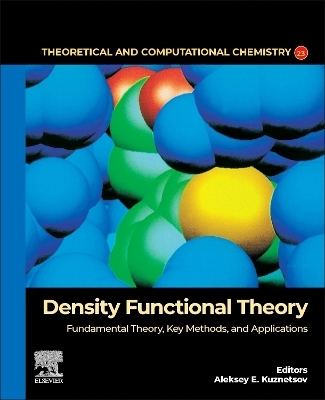
Density Functional Theory
Elsevier - Health Sciences Division (Verlag)
978-0-443-18977-7 (ISBN)
- Noch nicht erschienen (ca. Mai 2025)
- Versandkostenfrei innerhalb Deutschlands
- Auch auf Rechnung
- Verfügbarkeit in der Filiale vor Ort prüfen
- Artikel merken
Aleksey E. Kuznetsov obtained his Ph.D. in Physical Chemistry at the Department of Chemistry and Biochemistry, Utah State University, USA in 2003, after three years of doctorate studies with a specialization in Computational/Theoretical Chemistry. He has been working in various subareas of this field of research since 2000. After several postdoctoral and visiting professor positions in Germany, the United States, and Brazil, Dr. Kuznetsov obtained a permanent faculty position at the Department of Chemistry, Universidad Técnica Federico Santa Maria, Santiago, Chile. He has been working there since 2019, focusing his research on the computational design of various complexes of porphyrins, including core-modified porphyrins, with nanoparticles, fullerenes, and graphenes, along with studies of transition metal complexes, organic compounds with pharmacological applications, and more.
Part I: Foundational Knowledge 1. History of the DFT concept: inspiring ideas and development 2.DFT concept: Thomas-Fermi model and Hohenberg-Kohn-Sham theory, their comparisons and applicability 3. Exchange-correlation functionals: review, history, areas of applications 4. Novel and recently designed DFT functionals, their advantages and applications 5. Advantages and disadvantages of DFT compared to MO theory and other methods: scalability, ways to improve, areas of applications 6. Density matrix functional theory 7. Machine-learning of DFT functionals 8. Linear scaling of DFT methods 9. Future DFT development: theory, conceptual applications, computational improvement Part II: Methods and Approaches 10. Local-spin density approximation: history, present state, applications 11. GGA, meta-GGA, and hybrid functionals: development, applications, perspectives 12. Semiempirical DFT: DFTB, parametrization, present state, and perspectives 13. Dispersion corrected functionals: development, future perspectives, applications 14. Time-Dependent DFT: development, future perspectives, applications 15. Plane-wave approach 16. Relations between DFT and ab initio molecular dynamics 17. Relations between DFT and QM/MM approach 19. DFT methods use and peculiarities for vibrational (phonons) calculations 20. DFT methods use and peculiarities for transition state search 21. DFT methods use and peculiarities for various spectral properties investigations 22. DFT methods use and peculiarities for study of different spin-states 23. DFT methods use and peculiarities for chemical reactions studies 24. DFT methods use and peculiarities for solid-state studies Part III: Applications and Case Studies 25. Areas of good and poor performance of DFT: various multiplicities, weak interactions, loosely bound electrons, structures, chemical bonding 26. DFT in studies of complexes/systems with hydrogen bonding: history, present state, and perspectives, functionals used, ways to improve the performance 27. DFT in studies of complexes/systems with dispersion interactions: history, present state, and perspectives – complexes of graphene etc., functionals used, ways to improve the performance 28. DFT for reactivity studies/conceptual DFT: history, current state, and perspectives 29. DFT in design of pharmacologically active compounds: organic compounds, organometallic compounds, approaches used, perspectives and improvement routes 30. DFT applications in transition metal studies: history, present state, perspectives, functionals employed, issues and the ways to overcome them 31. DFT for design of compounds for alternative/sustainable energetics: history, present state, approach used and perspectives 32. DFT in design of anticorrosive compounds: current state, perspectives, approaches 33. DFT in engineering of crystals and related systems 34. DFT in design of semiconductors and oxides 35. DFT in catalysis studies: history, current situation, future, approaches used, problems and ways to overcome them 36. DFT in design of solid-state catalysts 37. DFT in studies of biologically relevant systems: history, present state, restrictions and problems encountered, future perspectives 38. DFT methods for large systems
| Erscheint lt. Verlag | 1.5.2025 |
|---|---|
| Reihe/Serie | Theoretical and Computational Chemistry |
| Verlagsort | Philadelphia |
| Sprache | englisch |
| Maße | 152 x 229 mm |
| Themenwelt | Naturwissenschaften ► Chemie ► Physikalische Chemie |
| ISBN-10 | 0-443-18977-3 / 0443189773 |
| ISBN-13 | 978-0-443-18977-7 / 9780443189777 |
| Zustand | Neuware |
| Haben Sie eine Frage zum Produkt? |
aus dem Bereich


